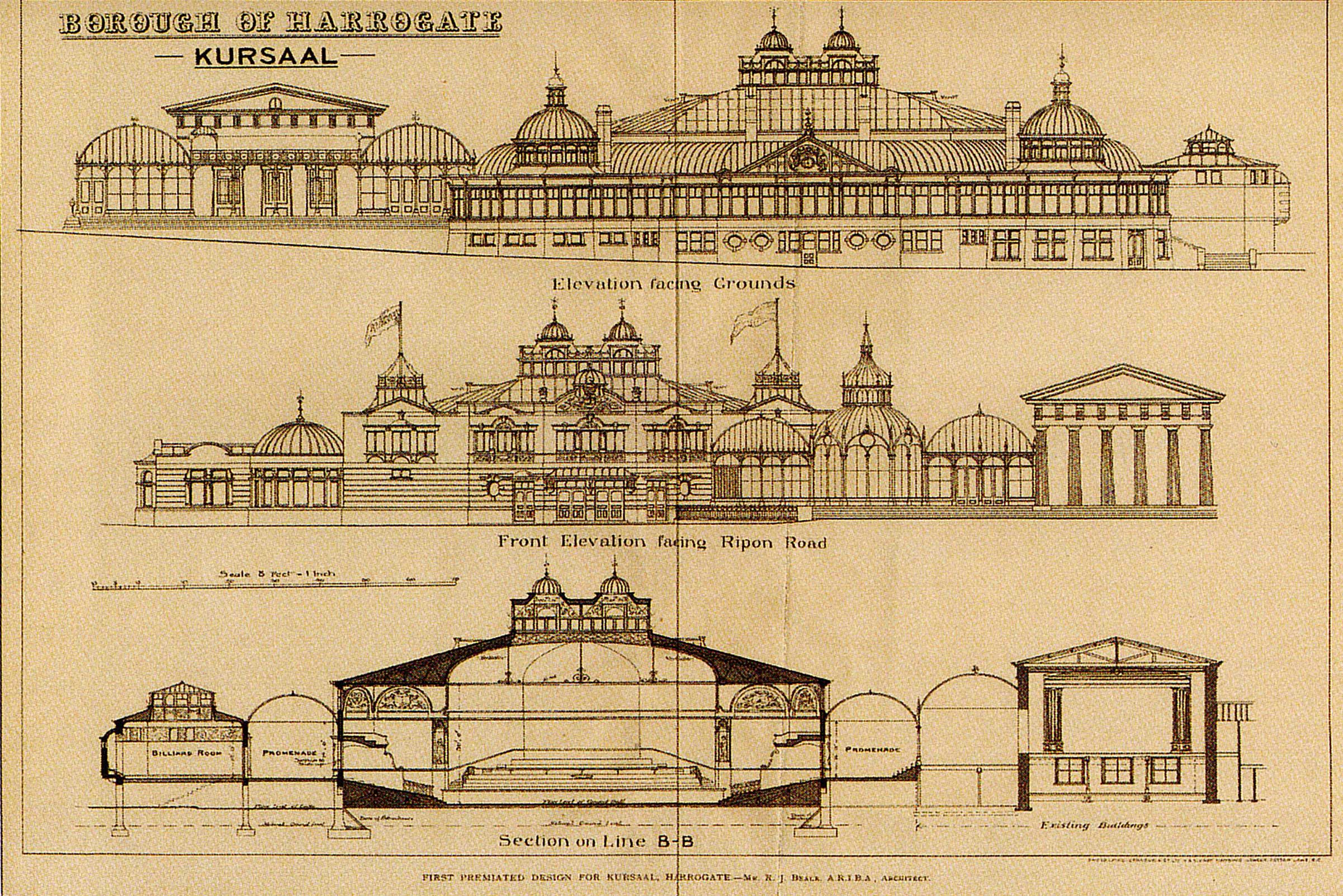From: Frank Lloyd Wright: Kursaal. A History of Harrogate’s Royal Hall, Harrogate International Centre 2008, pp. 6-13 (abridged)
‘The idea of
the kursaal, essentially a grand
reception hall and place of occasion for a spa town, had its beginnings in the
early nineteenth century, when lavishly appointed hotels with ballrooms, salons
and gaming rooms were built in places of resort and recreation. The first hotel
of this kind was probably in Baden-Baden in 1809.
The developing tendency in Britain through the nineteenth century was for assembly and recreational activities to form a loose grouping in the town centre, with inns, hotels and boarding houses in close proximity, but with the public facilities in several separate buildings, rather than under one roof or forming a grand architectural composition. On the continent, the name ‘kursaal’ or ‘kurhaus’ was commonly attached to the main place of assembly. Many continental spa and seaside towns still have architecturally ambitious groups centred on a kursaal, ranging from the magnificent in Marienbad to the relatively modest in Bad Oeynhausen. In many, the central building in the group was the casino. Monte Carlo was, perhaps, the prime example of this type, with its opulent casino and theatre (Charles Garnier 1878).
The dominant style was the extravagant baroque of the Second Empire, with bold modelling, juicy sculpture and prodigiously ornamented glass roofs. In Britain, the architectural style adopted in the spa towns was more that of Bath than of Marienbad or Monte Carlo.
The suggestion for the building of a kursaal [in Harrogate] was taken up in 1897. On Wednesday 21st June 1898 a deputation left Harrogate to visit the continent, to see how Harrogate’s rivals were managing. The kursaals at Ostend, Spa, Ems, Wiesbaden, Frankfurt, Homburg, Nauheim, Aix-les-Bains and Baden-Baden were much admired, special praise going to the musical potential of the Ostend Kursaal, which seems to have impressed the travelling deputation as a suitable model for the Corporation’s own venture (despite the fact that the model was centred on a casino).
However, the ambitions for a Yorkshire Ostend (without benefit of the subsidy provided by a casino) were clearly not going to be achieved within the specified ₤ 20,000 cost limit.’
The developing tendency in Britain through the nineteenth century was for assembly and recreational activities to form a loose grouping in the town centre, with inns, hotels and boarding houses in close proximity, but with the public facilities in several separate buildings, rather than under one roof or forming a grand architectural composition. On the continent, the name ‘kursaal’ or ‘kurhaus’ was commonly attached to the main place of assembly. Many continental spa and seaside towns still have architecturally ambitious groups centred on a kursaal, ranging from the magnificent in Marienbad to the relatively modest in Bad Oeynhausen. In many, the central building in the group was the casino. Monte Carlo was, perhaps, the prime example of this type, with its opulent casino and theatre (Charles Garnier 1878).
The dominant style was the extravagant baroque of the Second Empire, with bold modelling, juicy sculpture and prodigiously ornamented glass roofs. In Britain, the architectural style adopted in the spa towns was more that of Bath than of Marienbad or Monte Carlo.
The suggestion for the building of a kursaal [in Harrogate] was taken up in 1897. On Wednesday 21st June 1898 a deputation left Harrogate to visit the continent, to see how Harrogate’s rivals were managing. The kursaals at Ostend, Spa, Ems, Wiesbaden, Frankfurt, Homburg, Nauheim, Aix-les-Bains and Baden-Baden were much admired, special praise going to the musical potential of the Ostend Kursaal, which seems to have impressed the travelling deputation as a suitable model for the Corporation’s own venture (despite the fact that the model was centred on a casino).
However, the ambitions for a Yorkshire Ostend (without benefit of the subsidy provided by a casino) were clearly not going to be achieved within the specified ₤ 20,000 cost limit.’
 1899 Competition Entry Elevations.
1899 Competition Entry Elevations.From Kursaal, p. 24
 From Kursaal, p. 12
From Kursaal, p. 12 Elevations of final approved scheme.
Elevations of final approved scheme.From Kursaal, p. 17

